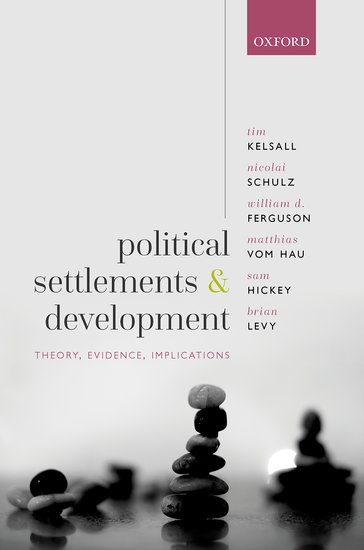Book Review - Political Settlements and Development: Theory, Evidence, Implications

Political Settlements and Development: Theory, Evidence, Implications by Tim Kelsall, Nicolai Schulz, William D. Ferguson, Matthias vom Hau, Sam Hickey, and Brian Levy. Oxford University Press. 2022.
If you hang around conversations on ‘thinking and working politically’, as I do, you’ll hear a lot of references to ‘Political Settlements’ as it’s grown up, more academic, but sometimes incomprehensible cousin. As this new book’s blurb declares ‘At its most ambitious, ‘political settlements analysis’ (PSA) promises to explain why conflicts occur and states collapse, the conditions for their successful rehabilitation, different developmental pathways from peace, and how to better fit development policy to country context.’
But ‘not all is well in the world of PSA’, with lots of disagreements over definitions and implications. This new book, by Tim Kelsall, Nicolai Schulz, William D. Ferguson, Matthias vom Hau, Sam Hickey, and Brian Levy (is there an authorial equivalent of a manel? But at least it’s Open Access – yay!), aims to establish PSA as a permanent part of the development landscape by unifying different strands of thinking, putting the concept on a sounder theoretical footing and examining the implications for policymakers.
 First the definition: a PS is ‘an ongoing agreement among a society’s most powerful groups over a set of political and economic institutions expected to generate for them a minimally acceptable level of benefits, which thereby ends or prevents generalized civil war and/or political and economic disorder.’
First the definition: a PS is ‘an ongoing agreement among a society’s most powerful groups over a set of political and economic institutions expected to generate for them a minimally acceptable level of benefits, which thereby ends or prevents generalized civil war and/or political and economic disorder.’
[My Translation: Avoiding costly upheaval by cutting in the big players so that they have a stake in political and economic stability.]
It proposes a 2×2 typology of political settlements. One axis measures whether elites include/exclude a broad range of players, which they call ‘social foundations’. If they’re inclusive, expect the PSA to spread the benefits around. If exclusive, expect kleptocracies.
The other axis is more about capacity – the political elite’s ability to get stuff done, which they unhelpfully call the ‘configuration of power’ (the book has the odd nice turn of phrase, but overall, is pretty heavy going). If that configuration is dispersed, there are too many cooks and no-one knows what is happening; if concentrated, then policies can be agreed and implemented.
This yields the following 2×2:
Broad social foundations – dispersed configuration: Good intentions, weak ability to implement. Short termism and populism/patronage likely to flourish, at the expense of long term economic development.
Narrow social foundations – dispersed configuration: Unwilling and unable to do much except steal/repress, often leading to instability as fractions of the elite squabble over the spoils.
Broad social foundations – concentrated configuration: Most likely to deliver inclusive development, with pressure both to deliver social benefits to a broad swathe of society, and the capacity to agree and implement long term development policies.
Narrow social foundations – concentrated configuration: With fewer pressures to spread the benefits in the short term, these regimes are better placed to force populations to forego immediate benefits, while pursuing long term economic development a la Asian Tigers.
The authors perform a big cross-country regression that broadly backs up their theoretical arguments: regimes with a broad social base deliver more social development; those with a tight concentration of power are better at economic development.
Is all this particularly useful? The test comes in the final 4 page ‘advice for policy makers’ section.
First, focus on the broad-concentrated settlements: ‘it is only in this type of settlement that finance or technical advice is likely to work well’.
In narrow-concentrated settlements ‘development partners will need to be more imaginative’. That means shifting political incentives to try and broaden the social foundations, e.g. by trying to convince the elites that educating the workforce might make them richer, or substituting for failed state provision eg via aid-funded parallel health and education services (not exactly a long term strategy). Where resources are a big source of revenue, global initiatives to encourage transparency/discourage theft, can help. Also find champions, work with civil society etc to broaden the social base.
In broad-dispersed settlements, ‘top down, system-wide reform efforts are unlikely to work’, but identifying and working with pockets of effectiveness and multi-stakeholder coalitions might help.
Narrow-dispersed settlements are the toughest nut to crack. What are donors supposed to do when the country (or at least the capital) is in the hands of a small group clinging on to power, trousering what they can, and unable to implement very much, even should they want to? Such places often ‘teeter permanently on the brink of conflict’. Here the book defaults to global governance, tackling global ‘bads’ like finance, taxation, arms, drugs etc to reduce the likelihoods of division and meltdown.
The problem is, as ever, that aid is increasingly targeted at the hardest-to-fix places – narrow-dispersed in this formulation (often fragile and conflict-affected states), because the broad-concentrated settlements mostly no longer need aid. Tricky.
Overall, some useful stuff in here. But (and I probably missed a lot of nuance, partly because the writing is so dense) I was left with a bit of a ‘meh’ feeling that this was essentially an unnecessarily complicated and inaccessible version of a 2×2 that Oxfam uses – are states/elites able and/or willing to do the right thing?
This first appeared on From Poverty to Power.


